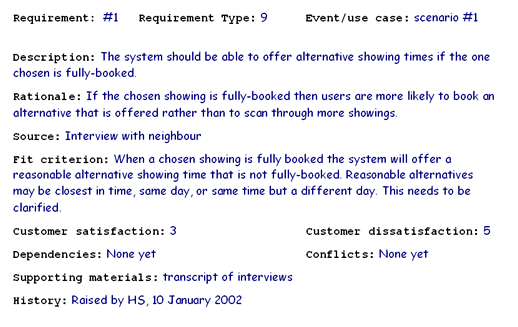|
Chapter Introduction
| Web Resources
| Assignment Comments
| Teaching Materials
This assignment involves you tackling the
requirements activity. For this assignment, we offer some
comments, and some partial feedback to help get you started
on each part of the assignment. These samples below are based
around the assumption that we are dealing with a cinema, but
you may be focusing on another kind of system.
[1] The
form of data gathering you use will depend on your circumstances.
There are plenty of people to talk to about how they obtain
tickets for an event. Remember to look closely at the intent,
and not to be blinded by the way things are now. Also refer
to the basic data gathering guidelines on page 216.
[2] One
user profile is a male student aged 17 who is partially deaf.
A scenario for this user might be.
"Dan enjoys taking part in virtual chat
environments. Late one night, he is in conversation with someone
who recommends that he go and see the latest James Bond movie
which has just come out. It's too late to phone the local
cinema to see if it's on there, so he decides to use the internet
to obtain some tickets for the following weekend. At the cinema
website he looks for the film titles currently showing. The
structure of the site is quite clear, and it's possible to
go straight to the information about films and showing times.
The James Bond movie is indeed showing. From this page, he
can indicate the time of his choice and order the tickets.
He chooses the 7pm performance, but the system tells him that
this is fully-booked and offers him alternatives: the 5.30pm
and the 8pm showings both have available seats. The system
displays the seating plan for the cinema which shows the available
seats for each showing, and how much each costs. Dan then
chooses the seats and showing time that he wants and confirms
the booking. Next year, when he has his own bank account,
he'll be able to pay for tickets online too and they can be
posted to him, but for now he must collect the tickets from
the box office and pay for them an hour before the film starts.
As he is partially deaf, he needs to double-check that the
cinema is equipped with suitable sound amplification technology
that links in to his hearing aid. Having completed his order,
he returns to chatting with his friends."
[3] The
tasks Dan was involved with were:
- Finding if the film was on at the cinema
- Finding out the times of the showing
- Choosing the showing
- Choosing the seat
- Confirming the booking
- Checking for other facilities at the cinema
If he had been able to pay then there would be a further task:
Paying for the tickets.
Note that this is not a complete HTA, but is a starting point.
[4] Some
basic considerations and example requirements from this scenario
are given below. Your scenarios may be very different, and
will hence yield very different requirements:
- Functional
The system should be able to offer alternative showing times
if the one chosen is fully-booked.
- Data
Film titles, showing times and ticket prices will be needed
- Environmental (physical, social, organisational,
technical)
The user might be in a variety of physical settings, and at
different times of day, e.g. at home, in the street, in the
rain, etc. In our scenario Dan was probably sitting at a desktop
computer but he could have been using a cell phone.
- User
· There are potentially many different kinds of user.
You must decide who your website is targeted for: children
under 18? only adults with a credit card? What about visually
impaired users, or the elderly who may have difficulties controlling
their movement?
- Usability
The website should be usable the first time, without any training.
This is an expression of the Volere
requirement for the functional requirement

|
